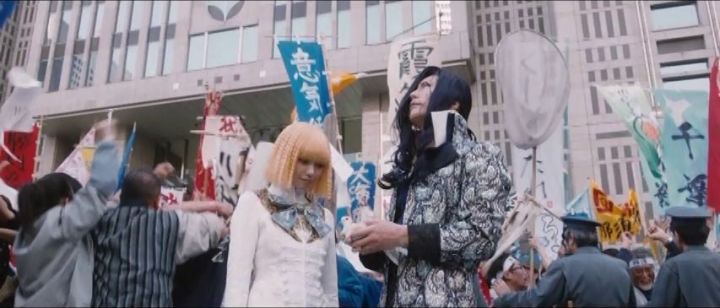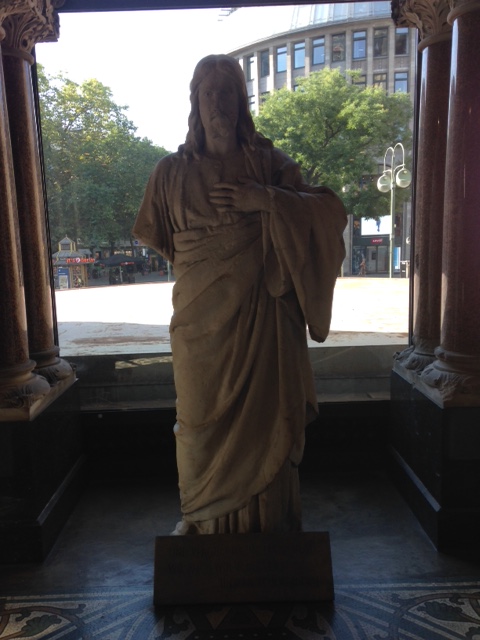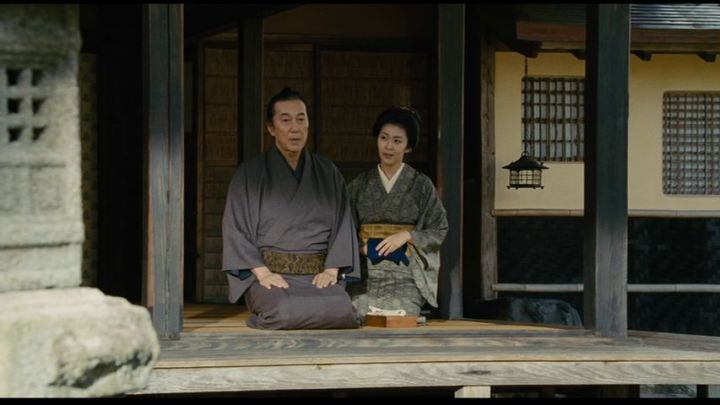
by Andrea Grunert
A hot day in Kumagaya, a city in Saitama, the prefecture adjacent to Tokyo (1), and at more than 40° Celsius it is hot enough to fry an egg on the pavement. And that is taken literally in Takeuchi Hideki’s (2) Fly Me to the Saitama (Tonde Saitama, Japan, 2019). Mr. Sugawara (Brother Tom) is frying an egg, not on the hob of a cooker but on the concrete outside his home. This comical moment is part of the story that forms the framework to the main plot. Its focus is on the Sugawara family – Yoshimi, the father, Maki, the mother (Asō Kumiko) and Aimi, the daughter (Shimazaki Haruka), who are leaving their home town for Tokyo, where Aimi’s engagement ceremony will take place.
The young woman dreams of life in the capital after her marriage, and what she is looking forward to most is escaping from provincial Saitama, geographically so close to Tokyo but at the same time so far from it. There is a stigma attached to Saitama, which is despised by the Tokyoites as a rustic, uncivilized place, and the film, based on a manga by Maya Mineo (3), depicts the rivalries between city and countryside, a conflict that is universal. Aimi’s desire to move to Tokyo is a reflection of the city’s attraction for the young woman. During the journey by car with her parents, she continually speaks disparagingly of provincial Saitama as a boring place, an attitude that upsets her parents. The scenes with the Sugawara family also reveal the inferiority complex that people from provincial towns and/or the countryside sometimes have towards big cities. Her father shamefully recalls a moment when this deep-rooted feeling of inferiority made him deny his origins – when he first met his future parents-in-law, a couple from Chiba Prefecture, he pretended to be from Tokyo.
Takeuchi also includes in his film information about Saitama that a Japanese person might know. The sequence with the egg refers to the fact that in August 2007 the highest temperatures ever recorded in Japan – 40.9° Celsius – was measured in Kumagaya (4). The comical scenes with the Sugawaras are the framework for the main plot, an urban legend that is broadcast on the radio during their journey by car to Tokyo. While the father is completely absorbed listening to the tale, the film projects the viewer into the narrative – a wild fantasy in which the rivalry between city and province is taken to extremes.
The urban legend is set in an imaginary time, a steampunk-like mix of past and present, of European and Japanese culture. Japan is a divided country with Tokyo on the one hand and the despised prefectures Saitama, Chiba and Gunma on the other. Japan’s capital city is depicted as a modern metropolis, a glittering high-tech world that contrasts strongly with its impoverished and undeveloped neighbouring provinces. At the élite school attended by the film’s two main protagonists Asami Rei (Gackt) and Dannoura Momomi (Nikaido Fumi) – the latter being the girlish-looking son of Tokyo’s governor (Nakao Akira) – there is a strict hierarchy that depends on the social status of the student and the part of Tokyo or Japan that they come from. Students from Saitama are treated as outcasts and required to live in a shack outside the school premises. Social difference is reflected not only in this dilapidated shack, which contrasts with the ostentatious school building, but also in the students’ clothes. Momomi and the female students from Tokyo wear elegant dresses or a uniform similar to that typically worn at Japanese schools. The costumes of the young Saitamites, however, are a random mixture of clothes similar to those worn by many Japanese during and immediately after World War II. The brownish jacket of the male student from Saitama is reminiscent of the uniform worn by low-ranking soldiers during World War II; the female students from Saitama wear blouses with sailor collars, but instead of blue or black skirts they wear patched monpe – another reminder of the war and wartime hardship (6).
Social exclusion and poverty are the result of the oppressive system imposed by the capital, and the film includes many examples of discrimination. The mere mention of the word “Saitama” leads to hysteria among the arrogant Tokyoites, even causing some of the female students to faint, and people from Saitama are avoided as if they were carriers of some contagious disease. They are the dehumanized Other known from racist discourses, and the government responds to Tokyoite fear of this Other from Saitama with a policy of strict segregation. The students from Saitama are denied medical care at the school, and residents of Saitama even need a pass to cross the border into the metropolis. They are hounded by a special branch of the Tokyo police, who detect Saitamites by means of an electronic device and arrest anyone suspected of being from that prefecture. The brutality is typical of a terror regime, with people from Saitama kept outside the city in a wasteland behind a fence while the governor of Tokyo resides in a magnificent palace.
This ruler of Tokyo behaves like a dictator, but Rei, who has recently returned from the United States, is the long-awaited saviour of Saitama. He finds a staunch supporter in Momomi, who has fallen in love with him. It turns out that Rei is the son of the mysterious Duke of Saitama (Kyomoto Masaki), a hero of the Saitama independence movement and leader of the Saitama Liberation Front. Together, father and son are fighting for the abolition of the pass system, for freedom and equality.
The portrayal of the conflict between capital city and countryside evokes situations and behaviour familiar to viewers from historical and present-day dictatorships, and it smacks of racism and discrimination. However, the film is not a sociological study but presents this serious topic in a playful manner. Costumes and set design constantly remind the viewer of the fiction he or she is watching. The architecture seen in the film combines modern skyscrapers with buildings inspired by European classicism. The rooms in the governor’s palace are filled with European-style furniture from the eighteenth and nineteenth centuries – golden candelabras, sparkling chandeliers, magnificent four-poster beds, a great deal of silk and furniture made of expensive kinds of wood. The governor’s wife wears a rococo-inspired dress with an ostrich feather in her opulent hairstyle and her husband is dressed like a daimyō (7) in an elegant kimono, formal haori (8) and hakama (9) – all reminiscent of Japan’s samurai heritage. This connection is also suggested by the governor’s family name, which is Dannoura and is a reference to a famous battle fought by samurai in the twelfth century (10). Many details in the film refer to Japanese history, for example the capes, hats, sandals and calf pads made of straw and worn by some of the characters in one scene (11). There is no medical doctor in backward Saitama, and instead there is a healer who is dressed like a yamabushi, an ascetic mountain monk of long ago.
References to Japanese history abound. The pass system recalls the strict rules in Tokugawa Japan (1603-1868), when travel permits were needed to leave one’s home province and control posts were established all over the country. Rei, suspected of being from Saitama, is forced to stamp on a giant rice cracker. Saitama is known as an important producer of rice crackers, and the Eurasian Collared Dove portrayed on the cracker is found chiefly in Saitama and is therefore used as the prefecture’s emblem. This scene in the film recalls a practice to which people who were suspected of being Christians were subjected at various times in Japanese history. They were forced to stamp on a cross in order to demonstrate their rejection of the Christian faith. In the film, the rice cracker symbolizes Saitama and is accorded the same significance for the Saitamites as the cross has for Christians.
Many of these thematic and visual references have been perpetuated in film, including the jidai geki, the historical films set in the Tokugawa period. It is noteworthy that Toei, the film’s distributor, was in the 1950s the studio that produced whole series of jidai geki. The portrayal of Gunma Prefecture as a jungle in which scientists have discovered giant footprints is another of the film’s cinematic references, this time to Godzilla – Gojira in Japanese – the monster accidentally created by nuclear tests (12). In Fly Me to the Saitama, the characters watch a television report on the discovery of the footprints, recalling a similar scene in Roland Emmerich’s Godzilla (USA, 1998). In the jungle of Gunma Prefecture, Momomi is confronted by a monster emerging from a river, and in a later sequence, it seems that Momomi is about to be sacrificed to it. The image of Momomi, tied up in front of the gigantic statue of the creature, recalls a plethora of films from Cabiria (Italy, 1913, Giovanni Pastrone) to King Kong (USA, 1933, Merian C. Cooper and Ernest B. Schoedsack). The monster even looks like one created by the French film pioneer Georges Méliès (1861-1939). However, it is only a paper-mâché monster in an entertainment park, and Momomi is reprieved at the park’s daily closing time.
Everything is fake, everything is illusion, and the cast contribute to this artful play in their appearance. The girlish boy Momomi, whose name is a girl’s name, is played by the actress Nikaido Fumi. This character – the governor’s son – develops from an authoritarian and somewhat callous young man into a caring person who changes his views on Saitama after being kissed by Rei. The androgynous appearance of the pop and fashion icon Gackt (13) heightens the way the film deals with gender in a clever and amusing ways. This playing with sexual identity also figures in Momomi’s dream with his fears for the man he loves and his jealousy. In this dream, Rei is in chains and Akutsu Shō (Iseya Yūsuke), the leader of the Chiba Liberation Front, gives his prisoner a very long, very sensual kiss. This kind of kissing scene between two men is still a rarity in mainstream cinema. The mixture of European and Japanese cultures in the film is a reflection of taste in Japanese culture since the Meiji era (1868-1912), and playing with fluid sexual identity challenges the views on gender and sexuality of the ruling authorities (14).
The film suggests that such divisions can be overcome. Before the battle against Tokyo, the Saitama rebels have to face their rivals from Chiba, a prefecture similarly oppressed by Tokyo. The Chiba Liberation Front led by Akutsu employs an odd form of torture that involves filling the orifices of their prisoners with peanuts, recalling another clichéd view of a particular region (15). The two rivalling prefectures try to outdo each other in a birthplace contest to see who has produced the greatest number of celebrities – singers, actors, actresses. The opposing crowds then clash in a mass brawl, but without any bloodshed. Their leaders, Rei and Akutsu, decide to combine their forces in order to put an end to Tokyo’s pass system and oppression. When they reach Tokyo, the once hostile groups face the brutality of the police that confront them in the streets. Footage of police operations at demonstrations and images of the Tokyo Marathon are incorporated into these scenes, and although the borderlines between archive material and footage shot for the film are blurred, they are nevertheless clear enough to reveal the illusion that is at the core of film as a medium.
Meanwhile, Momomi has exposed the corrupt system over which his father presides, and in the frame story set in present-day Japan, father and mother Sugawara proudly celebrate being Saitamites. A series of publicity-like shots from the present-day prefecture presents Saitama as a definitely habitable and economically successful prefecture.
In his film, Takeuchi toys with stereotypes, but he does so with great virtuosity in a colourful mix of visual and musical elements. Some of the comic elements may seem crude, but great attention is paid to detail, requiring the viewers’ full attention and captivating their imagination with a cast who visibly enjoy their roles. Nikaido, Gackt and Iseya manage to keep the balance between naturalist acting and theatricality, between seriousness and humour. In the opening sequence, Maya Mineo himself appears, telling the viewers: “This is a work of fiction.“ Fly Me to the Saitama is indeed a work of fiction and it does not take itself seriously, nor should it be taken seriously by viewers. However, the exaggerated style and visual flamboyance also point to the irrationality behind all racism and the origins of fear of the Other. Fiction is always rooted in reality, and Fly Me to the Saitama invites the viewer to grasp a deeper meaning behind its gaudy images.
Notes
(1) Saitama Prefecture is located north of Tokyo.
(2) Names are written according to Japanese conventions: family name before the given name.
(3) The manga was serialized in the manga magazine Hana to Yume in the early 1980s.
(4) In July 2018, a new record was set, with 41.1° Celsius, also measured, in Kumagaya.
(5) Chiba does not figure in the manga and was added because the director is from that prefecture.
(6) Monpe were loose trousers often worn by agricultural workers. During World War II, they became a standard garment for women and were turned into a symbol of wartime deprivation.
(7) Territorial lords in pre-modern Japan.
(8) A kimono jacket.
(9) A type of traditional Japanese skirt-like trousers
(10) The Battle of Dan-no-ura was a sea battle fought on 25th April 1185 between the Taira and the Minamoto, the latter emerging as victors. It marked the end of the Genpei War (1180-1185) and the beginning of two hundred years of Minamoto rule.
(11) People from the lower classes and travellers wore these clothes and accessories made of straw as protection against rain.
(12) Gojira first appeared in Honda Ishirō’s eponymous film, released in 1954.
(13) Gackt is the stage name of Ōshiro Gakuto, a singer-songwriter, J-pop/J-rock superstar, record producer and actor. Emphasizing an androgynous appearance, he is an important figure in the v-kei (visual kei) movement, which originated during the 1980s in Japan as a style of music with a strong focus on extravagant stage costumes.
(14) The manga is a yaoi, a boys’ love manga. It is a homoerotic subgenre of shōjō or girls’ comics featuring male/male relationships and intended primarily for young women.
(15) Chiba, the neighbouring prefecture to the east of Tokyo, accounts for 85% of Japan’s peanut production.

